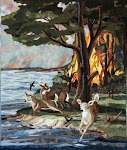 This time of year, there are many articles written offering help on many topics. Recently, I read an article about recommendations for starting home improvement projects and was struck by how similar the suggestions were to what I generally follow when creating my pictorial art.
This time of year, there are many articles written offering help on many topics. Recently, I read an article about recommendations for starting home improvement projects and was struck by how similar the suggestions were to what I generally follow when creating my pictorial art.• Plan-Plan-Plan. Winging it can be an artist’s best friend or the worst enemy. Acknowledge the difference. Establishing goals and milestone markers fall under this idea, too.
• Spousal support. No one needs a spouse laying cinderblocks on your creative path, stopping forward moment. Frequently, a spouse views these creative impulses as silly until the first works are sold, then suddenly, the light goes on and understanding is reached, as in "You can actually make money doing this stuff?"
• Ask for Help. Plowing ahead can ruin some great projects. Asking for help does not mean you are committed to following that help or direction. Example: I ask my husband frequently what he thinks of a new idea I have or what he sees during the initial stages of a new work. I also tell him up front that the question does not require him to make a decision or take action. It is just talk, feedback that I need, and I may not follow his advice. He has learned to understand what I am asking and does not sulk when I ignore his opinion or suggestions. No spouse? Establish a small support group of artist friends to handle this concern.
• Be realistic. Do you want to invest the time and money? Do you have the skills to do the project? If not…
• Develop the Skills you need. Take classes and workshops. Read. Research. Experiment. Do the baby steps that will advance your mastering of skills and techniques required to reach the anticipated end results. This step also has great long-term benefits because an artist’s next project will be better than the last one.
• Create a Budget. Determine the limits you are willing to spend if you have a tight budget. This is simply making the most of limited resources in order to reach the artistic goal. This may also suggest that conflicting budgetary demands may require re-evaluation and family cooperation. Where can I save money elsewhere so that I have the resources for the new projects? Again, be realistic, focus and be choosy about the next effort.
• Create a Materials list. Identifying the supplies needed in advance of starting a new work will reduce wasted time rounding up stuff, trips to the store, or waiting for the arrival of postal delivery. This step also saves money.
• Buy the right tools. This suggestion is not meant to provide the go-ahead to buy more tools. Rather, it means having the correct tools for specific tasks that the project requires, which eliminates frustration, poor workmanship and possibly on-the-job accidents. Invest in good quality tools, the best that you can afford. You may have to be patient and save up for the quality. You will have them a very long time and you will be happier.
• Take care of the tools. Properly clean, repair, sharpen, oil, and put away carefully at the end of usage means those tools will be available the next time. I still use paintbrushes that I bought 30 years ago because I bought the best I could afford, and carefully cleaned them every time I use them. I wipe off my good scissors, periodically clean the rotary cutter, and have my sewing machines routinely serviced.
• Measure Twice. Cut Once. Carpenters know this mantra–by–heart because it reduces waste and mismatched seams. If one is an artist that free–cuts and doesn’t like measuring anything, this tip may simply suggest that paying attention to what you are doing may eliminate the pain and suffering of not meeting the expectations.
• Be safe as you work. Developing good work habits may spare the artist injury from inhalation of toxic fumes, from the tools and from the lack of concentration as you are working. Be aware of your surroundings and what you are doing to protect yourself, but also to shield little children and perhaps your pets that share your workspace. If your mind is wandering, stop and do something else.
My final word of advice is:
A cluttered workspace leads to muddled thinking and chaotic working, which interrupts the workflow in general.




.jpg)



No comments:
Post a Comment